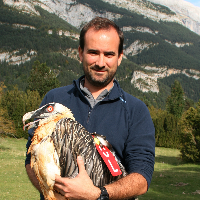Preprint
Article
Home-range Size and Space Use of Territorial Bonelli’s Eagles (Aquila Fasciata) Tracked by High Resolution GPS/GSM Telemetry.
This version is not peer-reviewed.
Submitted:
08 October 2022
Posted:
12 October 2022
Read the latest preprint version here
A peer-reviewed article of this preprint also exists.
Abstract
The current advent of GPS/GSM technology, with high resolution GPS dataloggers available, provides information of the highest quality, which is certainly better than previous tracking methods such as ARGOS telemetry or conventional VHF ground-tracking. As a result, this has improved our knowledge of home-range behavior and spatial ecology of many species, including large raptors. In this paper, we use satellite telemetry information to assess the home-range size and the role of individual, year, sex and season (breeding or non-breeding season) in space use of the Bonelli’s eagle (Aquila fasciata). To this end, 51 territorial individuals (25 females and 26 males) were equipped with GPS/GSM transmitters and were tracked over a 7-year period (2015-2021) in eastern Spain. Overall, we recorded 4,791,080 fixes that were analyzed through kernel density methods (50%, 75% and 95% fixed kernels). Average home-range size according to the 95% kernel, 75% kernel and 50% kernel were 54.84 ± 20.78 km2, 24.30 ± 10.18 km2 and 11.17 ± 4.90 km2, respectively. The home-range size of individuals occupying the same territory was similar, mainly due to the cooperative hunting behavior exhibited by the species. No interannual differences in the home-range of the same territory were found, showing a strong territorial fidelity of the breeding pairs. Overall, females’ home-range size were smaller than males’ ones due to the decrease of activity in the breeding season due to laying, incubation and chicks attendance at nests. No seasonal variation in the general home-range size was found. Moreover, we found low neighbor overlap among territories (4,18% ± 3.06%) that evidences a high level of intraspecific competition in Bonelli's eagles. Finally, this study highlights the advantages of the use of accurate telemetry information to improve our understanding of the spatial ecology of the endangered Bonelli’s eagle, which ultimately will serve to better inform management actions for its conservation.
Keywords:
Subject:
Biology and Life Sciences - Ecology, Evolution, Behavior and Systematicssupplementary.docx (4.39MB )
Copyright: This open access article is published under a Creative Commons CC BY 4.0 license, which permit the free download, distribution, and reuse, provided that the author and preprint are cited in any reuse.
Alerts
MDPI Initiatives
Important Links
© 2025 MDPI (Basel, Switzerland) unless otherwise stated







